Aprilia has created a new segment with it’s all-new RS660 parallel-twin. And it just might be the most usable sportsbike ever built for the road
Test Adam Child Photography Milagro
You gotta question why this hasn’t been done before. A fun, light usable sportsbike, which isn’t too radical or extreme, it’s attractive to young and new riders alike and has a plethora of sophisticated rider aids. Where’s it been?!
Take a usable parallel-twin motor that has character and punch on the road, place it into an easy-going chassis, then cover the lot in good-looking bodywork before giving it a just-about-affordable price ($18,490 plus on-roads)– what is not to like? I wish I had come up with this idea.
We’re told the supersport market is dead and sales show a monumental decline in this class over the last two decades, but these exciting, dedicated track bikes are simply that; racebikes with high revving engines and radical riding positions that can be hard work for everyday use on the road. But despite its supersport styling, Aprilia’s RS660 wasn’t designed for the track; this is a comfortable and un-intimating roadbike with a typically Aprilia sporting edge.

While the supersport sector has dramatically declined, the global demand for smaller-capacity bikes between 250-550c has increased, and Aprilia needed something to fit that growing market, especially in Asia. The Italian manufacturer also needed to produce a bike for loyal Aprilia customers wanting to stay with the brand as they moved up from the RS125. Aprilia didn’t have anything sporty in the middle market, so it made sense effectively to cut the 1100cc motor from the RSV4 in half and produce a completely new bike.
The RS660’s parallel-twin with a 270-degree crank is essentially the front half of the RSV4. But although the RS660 is a so-called entry-level bike for Aprilia and is designed for a young and inexperienced audience, it’s neither bland nor dull – the opposite in fact – and even uses more rider aids than Aprilia’s flagship superbike. Cornering ABS, multiple track and rider modes, traction and wheelie control, an up-and-down quickshifter, even cruise control make for a world-class array of electronic aids on a 73.5kW $20,000 bike.
As a fan and racer of the TT Lightweight class at the Isle of Man – the RS660 will be eligible for the 2021 TT – which consists of racy parallel twins, the RS660 grabbed my attention when it was unveiled two years ago. I’m also old enough to remember Aprilia’s legendary two-stroke RS250. The RS660 was a bike I’ve been so looking forward to riding.

All the ingredients are there. It has a short wheelbase (1370mm, 69mm shorter than Aprilia’s own RSV4 Factory); at just 169kg (dry) or 183kg with fuel, it is light, there’s adjustable suspension, a wide 180-section rear Pirelli Diablo Rosso Corsa 2 tyre, and even comes in the purple and red colour scheme reminiscent of the legendary RS250. Aprilia has always delivered excellent chassis, and I was like a starved dog outside a butcher, salivating with anticipation.
I was expecting the RS660 to be sharp and racy but it is far more relaxed than a wannabe track bike. The seat has some padding, the bars are relatively high and wide, the ergonomics are comfortable, with low pegs. You may think I sound disappointed, but I wasn’t. So many times I’ve jumped on a so-called sporty roadbike only to be disappointed by its performance, but that isn’t the case with the RS660. The parallel twin is a roadbike first and foremost, but one that can also be taken on the track.
The steering is light, which is exaggerated by the wide bars. It’s toy-like yet stable, giving you the option to steer into the corner, or hang off the inside, knee on the deck. Despite its lightness and willingness to steer, it’s stable and predictable. It is user friendly and welcoming, there is no ‘getting used to’ period – you just jump on and ride, safe in the knowledge you have excellent rider aids at hand, like cornering ABS should you arrive into a corner too hot.

We only got to test the RS660 on the road in the dry, and although the pace was brisk, we weren’t really pushing the handling limits. The front 43mm Kayaba fork is fully adjustable and were faultless on the test, while the rear unit is also adjustable (aside from compression) and even at a brisk road pace is hard to fault. Arguably it doesn’t have the plush ‘top-level’ feel of quality Öhlins units or similar and I’m sure you’ll need a little more support on track with race tyres. But, overall, it’s an easy-handling roadbike which can cut it and delivers light and positive handling.
Like the suspension, the brakes may be lacking headline-grabbing spec, but these standard radial Brembo stoppers, with braided lines and radial master cylinder are more than up for the job, especially when you consider the bike’s low weight and comparatively low top speed. When stopping 183kg from a top speed of 225km/h, you don’t need the most expensive race-spec Brembo stoppers. The feel is excellent, even the back brake and the ABS isn’t intrusive on the road.
Interestingly, you have three levels of ABS. The most intrusive is cornering ABS front and rear, mode two is similar but less intrusive, and mode one is conventional ABS on the front, not cornering ABS, and no ABS on the rear, which with the standard slipper clutch allows you back into corners for fun.

What Aprilia has done is essentially use the RSV4 as a base, chopping the V4 engine in half to produce a parallel twin. The bore size is the same as the RSV4 1100, but now the stroke is 63.9mm, not 52.3mm. The twin-cylinder DOHC engine produces a respectable 73.5kW (100hp) at 10,500rpm and 67Nm at 8500rpm, that is more torque than a Yamaha YZF-R6 and Honda CBR650R. The little twin will bounce off the rev limiter at 11,500rpm but with a race kit will rev on for another 1000rpm. But this isn’t a race engine; 80 percent of the torque is at just 4000rpm and 90 percent is at 6250rpm.
Of course, it’s not as simple as just chain-sawing the V4 in half. There’s a new clutch, a new intake system, a new cylinder head, new 48mm throttle bodies. This is a completely new engine, albeit one that leans on the experience and knowledge gained from the V4. Aprilia has cleverly reduced vibration and allowed the engine to run smoother, with 270-degree counterweights on the new 270-degree crankshafts. The engine is a structural part of the bike, too, the swingarm bolts directly to the rear of the engine. Aprilia has clearly invested a huge amount of time and money into this new engine platform and I’m sure we will see more bikes from their range using this engine.
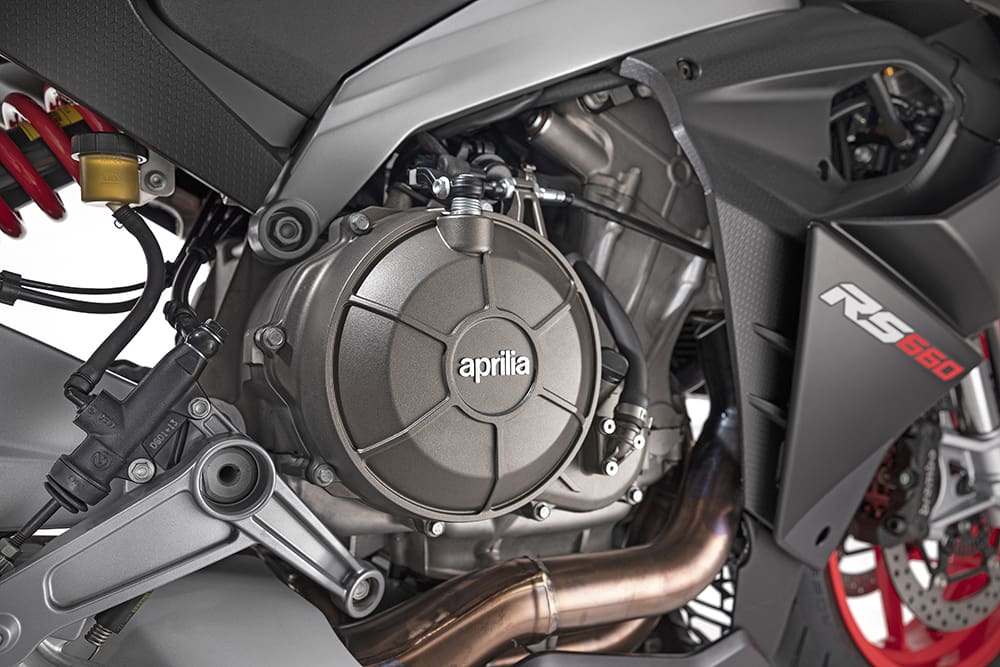
The 270-degree crank gives the RS660 a unique exhaust tone, very much like a slow-revving RSV4. It doesn’t sound like a Kawasaki Z650 (with a 180-degree crank), with each cylinder balancing each other – this is much smoother. The light, one-piece 6.2kg exhaust consists of one silencer per cylinder plus a catalytic converter, exhaust/collector box, which then exits on either side of the rear tyre. The two protruding exhausts not only gives the 660 a unique sound but also a distinctive symmetrical look.
A tickle of the ride-by-wire throttle allows the revs to dart up the full colour TFT digital dash. The revs build effortlessly, quicker than I was expecting, and for a standard exhaust, the system adds a little soul to the RS660 experience.
There are five riding modes to choose from: three for the road – Commute, Dynamic and Individual – and two for the track – Challenge and Track Attack. Each mode changes the engine character, feeling and the multiple rider aids, including traction and wheelie control, cornering ABS, engine brake assist, while the-up-and-down quickshifter which comes as standard is the same in all modes. Again, you can change and personalise each mode if you wish.
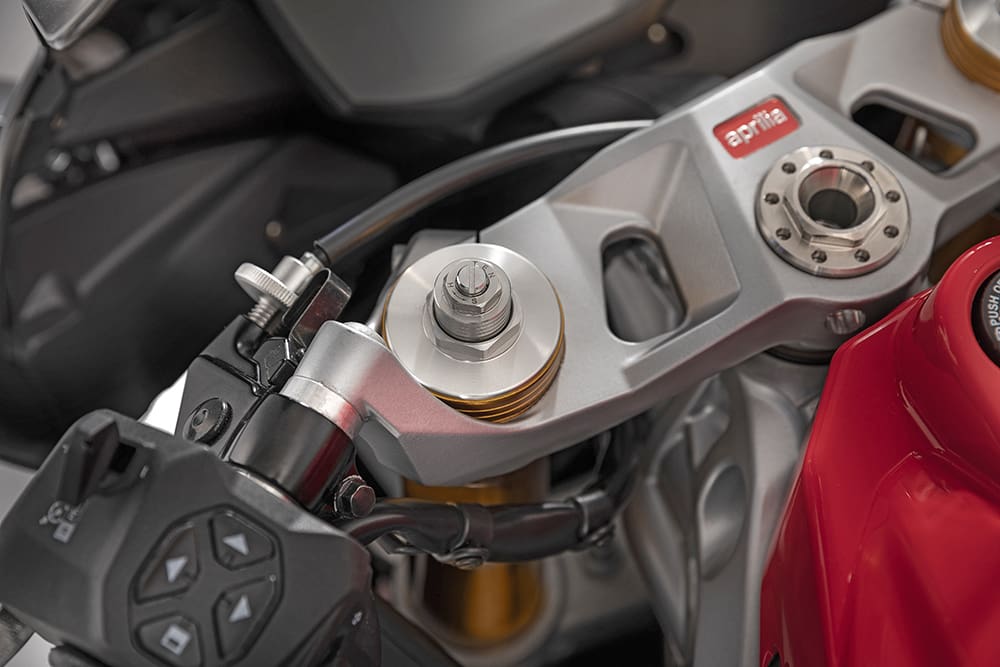
It may sound a little complicated for a so-called entry-level middleweight but, in reality, it isn’t. It’s simple and intuitive, the new switchgear makes it easier than ever (even if I do prefer the thumb and finger paddle of the RSV4).
We started our test ride negotiating small city streets before heading to the playground of the mountains. I opted for the commute mode, with the fuelling set to three, the softest setting. Like every other Aprilia I’ve ridden recently the fuelling was perfect. Aprilia has a world-class fuelling team, throttle response is always perfect, which is particularly impressive for a parallel twin. Again, like the premium RSV4 1100, the quickshifter is perfect too.

Within a few kays, the RS660 feels like a premium bike. On one or two occasions I struggled to find neutral, but that is my only gripe. As we headed into the Alps it was time to flick from Commute mode to the Dynamic mode, which automatically changes the engine character and response, and reduces the intrusion of rider aids. You can feel the difference, the response is a little sharper, especially from a closed to an open throttle. It’s not snatchy, the fuelling is again excellent, there is simply more urgency. Power is relatively linear and you can short-shift on the fast quickshifter and still make progress, but thrill-seekers will head above 7000rpm. There’s a little kick around 7500rpm, and the little twin loves to rev to the limiter at 11,500rpm. It sounds fantastic too. It’s so much fun to thrash, tapping up and down the quickshifter with the clutch redundant, excellent rider aids and cornering ABS on hand if the road surface should unexpectedly change… I really felt I could attack the Alpine mountain passes as if they were my local roads.
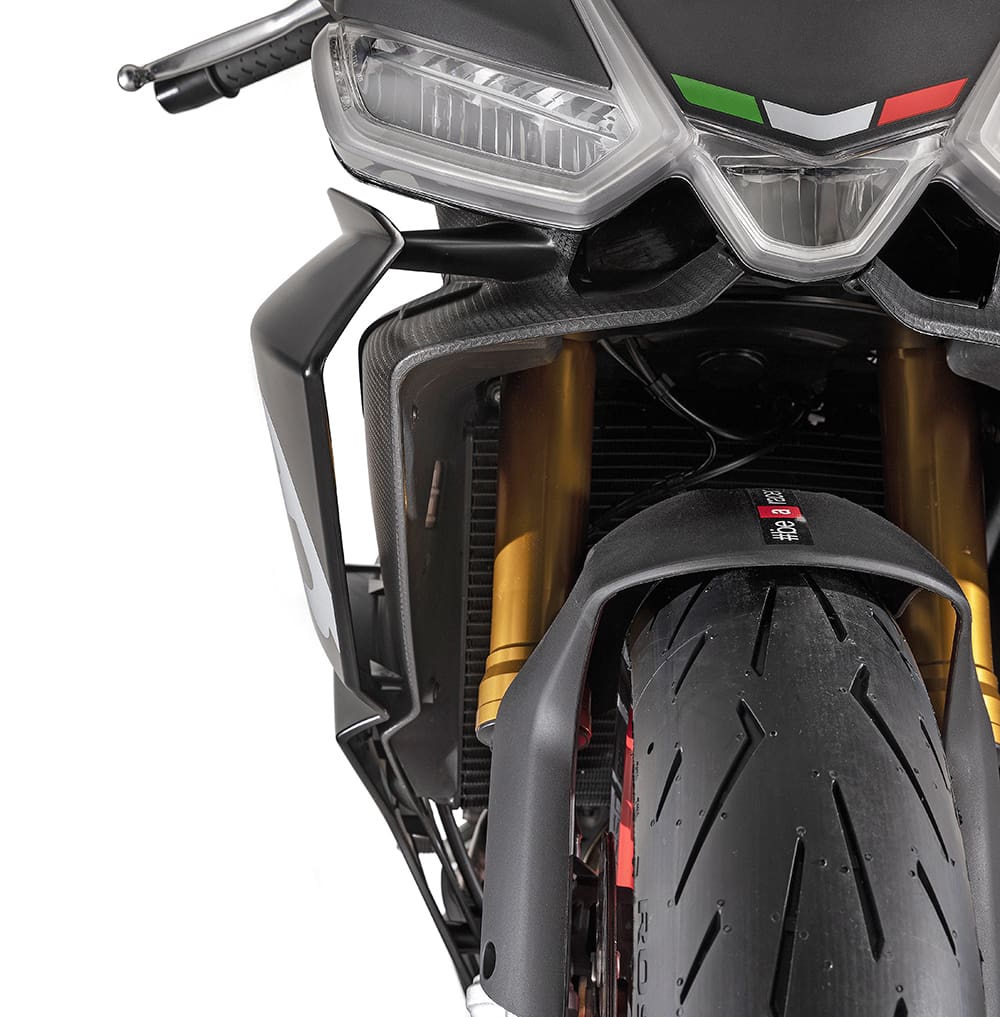
Then, for sheer (and immature) fun, I switched into the Individual mode, which I’d already pre-set for no traction control, no anti-wheelie, power on the most aggressive mode, engine braking down to one, and ABS set to one, which means only conventional ABS on the front, not cornering ABS and no ABS on the rear.
And, yes, the RS660 will wheelie in the first two gears with some encouragement from the clutch. It’s a brilliant engine to thrash, it sounds good, is responsive and fun, and blessed with excellent fuelling and a synchronised quickshifter. And thankfully, when you look down at the full colour TFT dash, you’re not doubling the speed limit and facing a jail sentence should you get caught. Yes, the RS660 is reasonably quick, I’d estimate top speed is around 225-230km/h, but unlike a RSV4 it’s not scary on the road, instead it’s usable and a few handfuls of the throttle in the first three gears won’t result in warp speed and the potential for instant disqualification.

The 15-litre fuel tank may not seem very large but the new parallel twin is frugal on fuel. Aprilia quotes 4.89L/100km, but on a steady ride in the afternoon I managed 4.15L/100km, which gives a theoretical tank range of over 321km. Three or four hours in the saddle wouldn’t be agony either, because the seat is comfortable and the ergonomics are roomy. The bodywork is also impressive; the screen is almost a double bubble TT-style screen, making it easy to get tucked in at speed, and at motorway cruising speeds does a half-decent job of wind protection.
At 6000rpm in top, you’re doing 120km/h and, while there are a few vibrations felt from the pegs and a little from the bar ends as the speed and revs increase, it’s nothing untoward, though we only managed a short blast on the motorway. Aprilia even offers a tail pack and a tank bag as optional extras, and I’d happily take on some serious miles on the RS660, especially as there is even cruise control.
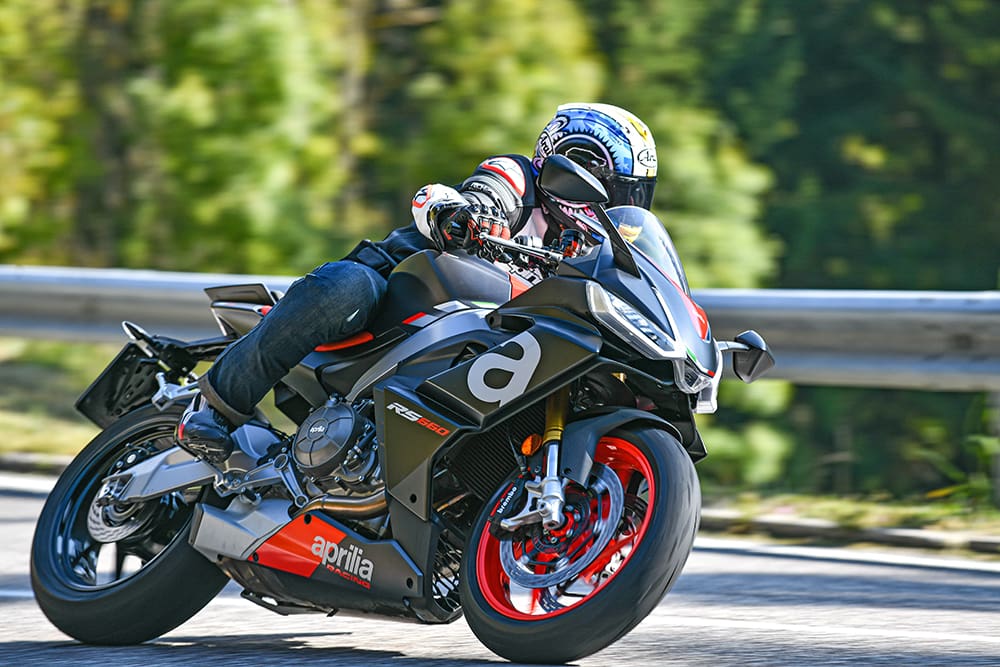
You could argue that so many rider aids aren’t needed on a 73.5kw middleweight already equipped with an excellent chassis and tyres. But you have to remember the young audience which Aprilia is attracting, and for more experienced riders they can be de-activated even on the move.
At your disposal are multiple rider modes, eight-stage traction control, wheelie control, engine brake assist, plus cornering ABS and conventional ABS. Additionally, you have cruise control and an up-and-down quick-shifter. The modes are easy to change on the move, and you can even deactivate the traction and wheelie control on the go, too. The new switchgear is intuitive and the clocks are simple and easy to read.
Although the array of rider aids is impressive, the RS’s rider aids aren’t displayed on the main menu while riding. The rider modes are clear but you can’t, for example, glance down and see how much TC you’re running – that info is within a sub-menu.
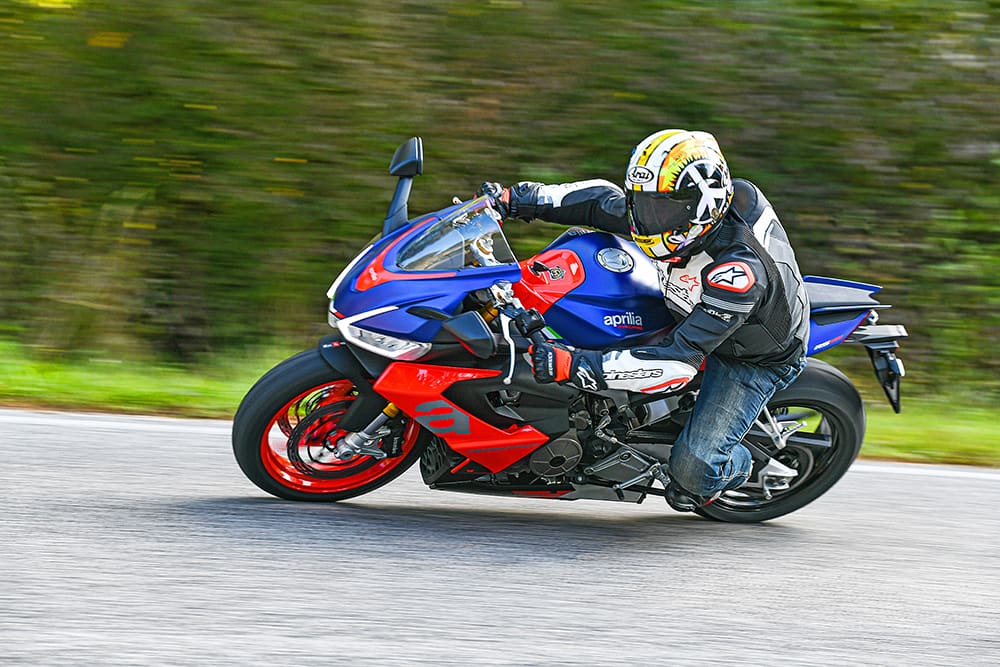
As you’d expect there are the usual accessories from Akrapovic, including a full race and road exhaust. There is also additional software available which means you can flick over to a race shift, and have access to a pitlane limiter. Away from the racetrack, there is a comfortable seat, USB socket, luggage… even a larger fairing and Bluetooth connectivity.
I’m impressed with Aprilia’s new RS660. It appears Aprilia has listened to the market and produced a usable, friendly, road-going sportsbike laden with rider aids and made it affordable, just. It’s not extreme; instead it is comfortable with a versatile engine that shouldn’t get you into too much trouble. It sounds good, has character, looks great and is certainly desirable. You could argue Aprilia has overdone the rider aids, and the suspension may need an upgrade for some serious racing/track action – but I’m sure there will be a sportier version in the pipeline soon.
A versatile, fun, desirable bike for the inexperienced and experienced alike, which I can’t wait to try on track. I believe this will be an Aprilia success story and a big step for the famous Italian brand.
